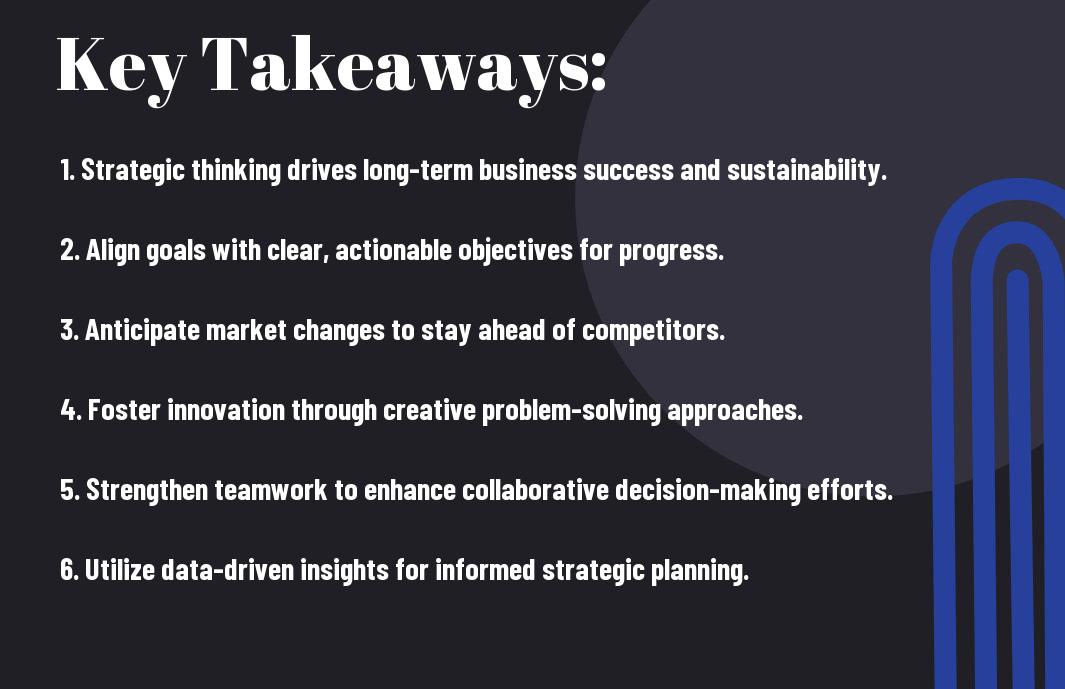
Just as a solid foundation is imperative for a building, strategic thinking serves as the backbone for your business growth. By honing your ability to anticipate challenges and identify opportunities, you empower yourself to make informed decisions that can lead to sustainable success. This post will guide you through the key elements of strategic thinking, illustrating how it can enhance your business acumen and drive expansion. Unlock the full potential of your enterprise by embracing this vital skill, which can transform your vision into reality.

Understanding Strategic Thinking
While strategic thinking may seem like a complex concept, it fundamentally involves evaluating your business’s current position, anticipating future trends, and making informed decisions that align with your long-term goals. This process enhances your agility in adapting to changes in the market and fuels sustainable growth.
Definition and Importance
Below, you will find that strategic thinking is the process of planning and forecasting with the aim of driving better decision-making. Its importance in business growth cannot be overstated, as it empowers you to identify opportunities, mitigate risks, and allocate resources efficiently, all of which can lead to improved performance and competitive advantage.
Key Components of Strategic Thinking
Understanding the key components of strategic thinking will enhance your ability to formulate effective business strategies. These components include vision, analysis, creativity, and alignment; each plays a pivotal role in shaping your strategic approach and ensuring your goals remain focused and achievable.
Thinking about vision involves setting a clear direction for your organization, which helps you define your long-term objectives. Analysis is about gathering data and insights that inform your decisions, while creativity encourages you to explore innovative solutions in response to challenges. Lastly, alignment ensures that all aspects of your business work cohesively toward achieving your strategic goals, fostering synergy and enhancing overall performance.
The Role of Strategic Thinking in Business Growth
Even in a rapidly changing business landscape, strategic thinking sets the foundation for sustainable growth. By analyzing your market, understanding your unique value proposition, and setting long-term goals, you can ensure your business remains agile and competitive. A solid strategic framework allows you to navigate challenges effectively while leveraging opportunities for expansion, thus promoting overall organizational success.
Identifying Opportunities
Identifying potential opportunities begins with a comprehensive analysis of market trends, customer needs, and competitors. By staying attuned to shifts in the industry and remaining open to feedback, you can discover new avenues for growth that align with your business’s vision and goals.
Risk Management and Decision Making
Making informed decisions is vital for navigating uncertainties in business. By incorporating strategic thinking into your risk management processes, you can anticipate potential challenges and evaluate the implications of your choices, ultimately fostering resilience and adaptability.
At its core, effective risk management enables you to weigh potential gains against possible losses, guiding you toward better decision-making outcomes. By implementing tools such as scenario planning and SWOT analysis, you can create a robust framework that not only helps you address immediate concerns but also prepares you for future challenges. This proactive approach allows you to focus on seizing opportunities while safeguarding your business against unforeseen hurdles.
Developing a Strategic Mindset
Unlike conventional thinking, developing a strategic mindset requires you to look beyond everyday tasks and envision the long-term impact of your decisions. By embracing this forward-thinking approach, you will enhance your capacity to navigate complex business environments, make informed choices, and seize emerging opportunities for growth. The key lies in adopting a proactive stance and continuously seeking ways to improve both yourself and your organization.
Cultivating Critical Thinking Skills
Among the various skills needed for effective strategic thinking, cultivating critical thinking is vital. This involves assessing situations from multiple angles, evaluating evidence, and drawing logical conclusions. By honing your critical thinking abilities, you empower yourself to tackle challenges with confidence and create well-informed strategies that drive business success.
Encouraging Collaborative Planning
Critical to fostering a strategic mindset is encouraging collaborative planning within your team. This approach allows for the sharing of diverse perspectives and ideas, which can lead to more innovative and effective strategies. By actively engaging your team in the planning process, you not only enhance their ownership of the outcomes but also build a stronger, more cohesive unit that is invested in the organization’s vision.
The key to successful collaborative planning lies in creating an inclusive environment where everyone’s input is valued. Encourage open dialogue and brainstorming sessions that enable team members to share their insights and ideas. By leveraging the collective knowledge and expertise of your team, you can identify potential challenges, explore new opportunities, and develop well-rounded strategies that cater to your business goals. This synergy not only boosts creative problem-solving but also strengthens interpersonal relationships, ultimately leading to a more dynamic and agile organization.
Implementing Strategic Thinking in Business Practices
For your business to thrive, integrating strategic thinking into your daily operations is key. This involves fostering a culture that values foresight, encourages innovative ideas, and ensures that every decision aligns with your long-term objectives. By embedding strategic thinking into your practices, you can streamline processes and enhance your team’s performance, ultimately driving sustainable growth.
Case Studies of Successful Companies
Along with theoretical insights, learning from companies that have successfully implemented strategic thinking can provide actionable lessons. Consider the following case studies:
- Apple Inc.: Achieved a 30% increase in profits in 2022 through strategic diversification in service offerings.
- Amazon: Grew its market share by 25% after implementing predictive analytics in supply chain management.
- Coca-Cola: Realized a 15% boost in sales following a strategic focus on sustainable packaging initiatives.
- Netflix: Expanded its subscriber base by 50% after shifting its strategic focus towards original content.
Practical Steps for Integration
For you to effectively integrate strategic thinking into your business, start by assessing your current practices. Identify areas where strategic alignment is lacking and prioritize training for your team on critical thinking and problem-solving techniques. Regular strategy meetings can also help keep everyone aligned with your overall vision.
Integration of strategic thinking involves regularly evaluating your objectives, adapting to industry changes, and encouraging open communication among your team members. Set measurable goals and use data analytics to inform your decisions. By creating a systematic approach, you empower your team to contribute to your business growth through innovative and strategic insights.
Measuring the Impact of Strategic Thinking
Now that you understand the essence of strategic thinking, it’s crucial to measure its impact on your organization’s growth. By evaluating how your strategic initiatives translate into tangible results, you can refine your approach and enhance performance. This measurement enables you to pinpoint successful strategies, identify areas for improvement, and ensure that your business remains agile in a competitive landscape.
Key Performance Indicators
Across industries, Key Performance Indicators (KPIs) serve as valuable tools to evaluate the effectiveness of your strategic thinking. These metrics help you track progress and assess the impact of your strategies on business performance, ultimately guiding your decision-making process. By defining specific KPIs, you gain quantitative insights into your operational success and strategic alignment.
Continuous Improvement Strategies
The commitment to continuous improvement should be at the heart of your strategic thinking. By fostering a culture that embraces adaptability and learning, you can ensure that your strategies evolve with changing market dynamics. This proactive approach allows you to identify opportunities for enhancement and implement changes that drive business growth.
This mindset encourages you to regularly evaluate your processes, solicit feedback, and analyze performance data. By integrating these strategies into your operations, you foster an environment where innovation thrives, enabling your organization to respond effectively to challenges and capitalize on emerging opportunities. This commitment to improvement means that you and your team can continuously refine your strategic thinking, leading to sustainable business growth.
Challenges to Strategic Thinking
Not every business successfully embraces strategic thinking, as various challenges can hinder its implementation. Recognizing these challenges is the first step toward overcoming them, allowing you to foster a more agile and forward-thinking environment within your organization. By identifying potential pitfalls early, you can lay the groundwork for more effective decision-making and business growth.
Common Roadblocks
Between the complexities of daily operations and the fast-paced nature of market demands, many businesses encounter common roadblocks that stymie strategic thinking. These obstacles often include a lack of resources, unclear objectives, and resistance from team members who may be accustomed to traditional methods. Acknowledging these impediments is imperative for cultivating a proactive approach to strategy.
Overcoming Resistance to Change
Along with the usual operational challenges, the human factor often presents the most formidable barrier to strategic thinking. Team members may fear change due to uncertainty about their roles or skepticism about new initiatives. Building a culture that embraces innovation can help mitigate this resistance and encourage a more adaptable mindset.
Considering the emotional and psychological barriers that individuals face when confronted with change, it’s vital to communicate openly and transparently with your team. Providing clear reasoning behind strategic shifts can alleviate fears and foster a sense of ownership among employees. Engaging your team through discussions, offering training, and actively involving them in the change process can facilitate smoother transitions. By prioritizing a supportive culture and addressing concerns head-on, you can help your team embrace new strategies and drive your business forward.
Conclusion
Summing up, leveraging strategic thinking is vital for your business growth. By applying analytical frameworks and fostering a forward-thinking mindset, you position yourself to identify opportunities, mitigate risks, and make informed decisions. This approach empowers you to align your resources effectively and adapt to changing market dynamics, ultimately enhancing your competitive edge. Embrace strategic thinking not just as a process, but as a fundamental aspect of your business philosophy, ensuring sustainable growth and long-term success.
Leave a Reply